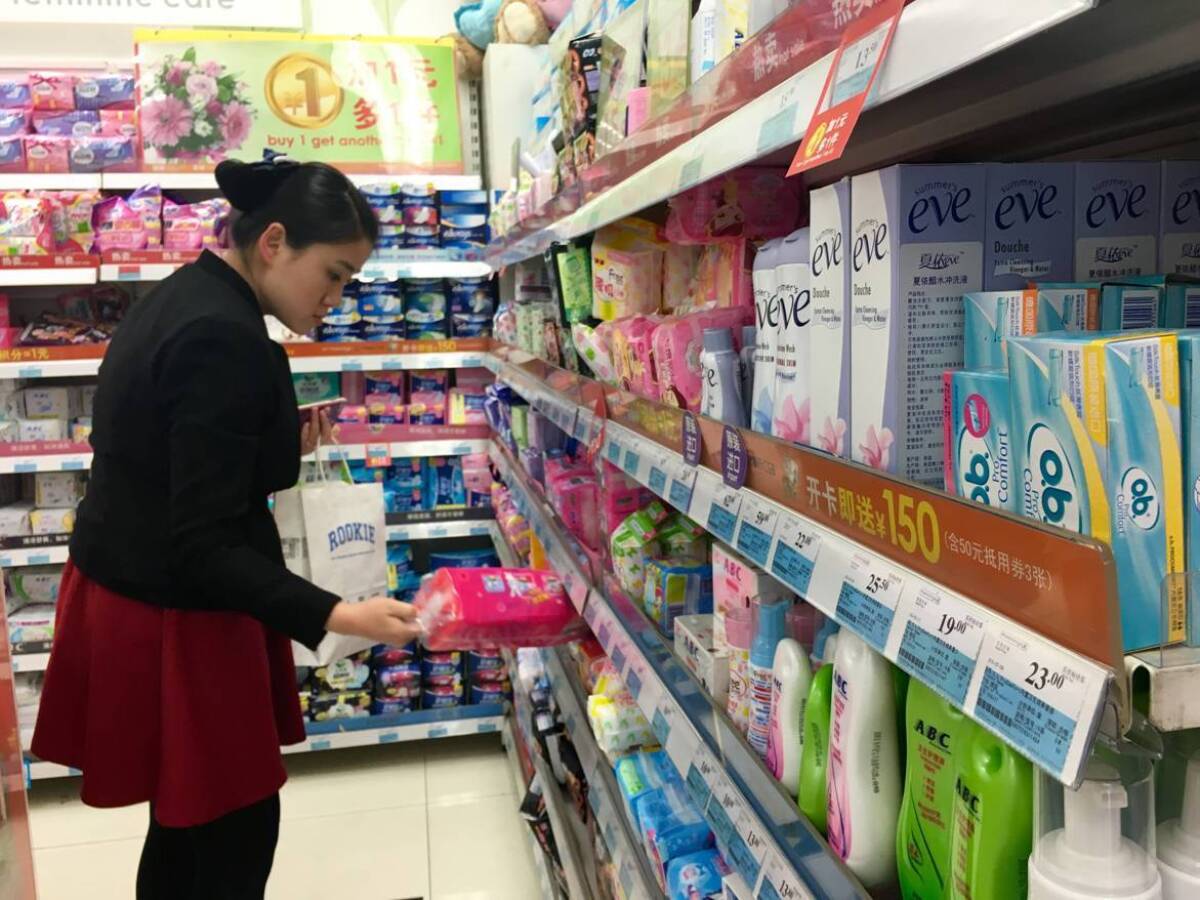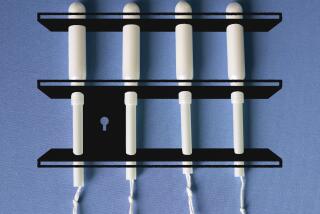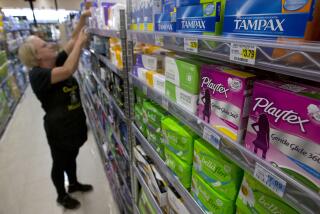China made 85 billion sanitary pads last year, and not one tampon. Here’s why

A Chinese woman looks for sanitary pads in a store in central Beijing, where tampons occupy a small corner on the shelf of feminie hygiene products.
Reporting from Beijing ‚ÄĒ Simon Lai has no personal need for tampons. But this year, the resident of southern China‚Äôs Guangdong province expects to buy more than half a million dollars worth of the feminine hygiene products in Los Angeles, ship them across the Pacific, and sell them for a good profit.
His business on Alibaba’s e-commerce site Taobao is called Puff House, and it specializes in personal care items. Between June of last year and January, he sold $180,000 worth of imported tampons, making him the biggest vendor of Tampax products on the platform.
‚ÄúThe tampon business has grown much quicker than I expected,‚ÄĚ Lai said.
Lai is filling a void in the market. Although Chinese consumers have in recent years embraced countless Western products including Levi’s jeans, Converse shoes, Chanel perfume and Nivea antiperspirant, a complex mix of cultural and commercial factors have kept tampons from widespread acceptance, and interest in them is just starting to take off.
Tampons came first came into use in the United States in the 1930s, and more than 70% of American women now use them., But while Chinese manufacturers produced 85 billion sanitary napkins last year, not a single one of them made tampons.
There are many barriers to acceptance in China, starting with a lack of sex education. Even young Chinese women say they know little about their body parts and fear (mistakenly) that tampons will break their hymen and rob them of their virginity.
China‚Äôs media regulator, meanwhile, has banned advertisements of feminine hygiene products on TV at lunchtime and during prime time, reasoning that such commercials, along with ads for hemorrhoid treatments and foot disease remedies, were ‚Äúdisgusting.‚ÄĚ
See more of our top stories on Facebook >>
Only $190 million worth of tampons were sold in China in 2013, according to Mintel, a London-based market research company. While that was up 8.7% compared with a year earlier, those sales equaled just 2.5% of the $7.6-billion sanitary pad market.
Yuan Rong, product manager of Ladycare, China‚Äôs fifth-largest sanitary pad maker, said the tampon market was still immature. ‚ÄúWe‚Äôve been doing research on tampons since a decade ago, but China‚Äôs tampon market is not big enough for us to produce any,‚ÄĚ she said.
Johnson & Johnson’s O.B. tampons appeared on shelves in China in 1993 and are still the only brand sold in stores. They are generally stocked only in higher-end shops, such as personal health and beauty retailers Mannings, or foreign megamarkets like Wal-Mart.
Liu Li, a Mannings store clerk in Beijing, said she’s seen an uptick in interest. A year ago, she was selling about six boxes of tampons a month. Now it’s about six boxes per week.
According to Lai, most of his tampon customers are young white-collar workers in big cities such as Beijing, Guangzhou and Shanghai, including many women who have returned to China after living overseas for some time. Chinese girls, he said, are often told by their mothers, ‚ÄúUse tampons after you get married.‚ÄĚ
Li Yinhe, often described as China‚Äôs first sexologist, said despite increasingly liberal attitudes toward sex, the country still has a ‚Äúvirginity fetish.‚ÄĚ There are many clinics offering hymen repair surgery so that sexually active women can present themselves to their fiances as virgins, noted Li Sipan, founder of Women Awakening Network, a feminist organization in Guangzhou.
But Li, the sexologist, said attitudes and customs are changing. Before 1989, only 15% of Chinese had had sex before marriage, but by 2013, that number had risen to 71%, she noted.
For some Chinese feminists, tampons are a weapon for them to assert themselves and refute myths about virginity. ‚ÄúI use whatever I want during menstruation. I don‚Äôt care if men think my hymen is intact or not,‚ÄĚ said Wu Dengmin, a 20-year-old junior at Anhui Normal University. ‚ÄúI don‚Äôt care how my behavior will be measured by those conservative women either.‚ÄĚ
Wu was born and bred in Anhui province, and grew up surrounded by messages about sexual purity. Among the province’s most famous tourist sites are female chastity memorial arches built by local governments between the 14th and 20th centuries to honor widows who never remarried, and to this day are seen as totems to promote the idea that women should only have sex with one man in their lifetime.
Wu said her high school biology textbook contained pictures of only male genitals, and she taught herself to use tampons at 16 by studying pictures online. She never told her mother.
‚ÄúMy mom would think I‚Äôm not a good girl any longer,‚ÄĚ she said.
Safety concerns about Chinese-made sanitary pads are driving some Chinese women to tampons. Two years ago, reports surfaced that some Chinese-made pads might contain fluorescer ‚ÄĒ a cancer-causing agent.
After that, He Yuelin, 32, a human resource manager for an airlines company in Shanghai, said she began to buy U.S.-made pads via Taobao.
Sensing that China might be on the cusp of embracing tampons, French businessman Jeremy Rigaud launched a tampon brand called Wishu in Shanghai in 2012. Wishu buys tampons from manufacturers in France and Italy, labels them with Wishu’s logo and sells them in China, through online platforms such as JD.com.
Last year, Wishu‚Äôs revenue reached about $770,000, Riguad said. ‚ÄúI see many potentials in China‚Äôs tampon market,‚ÄĚ he said, adding that he‚Äôs now working on distributing Wishu tampons via supermarkets in China‚Äôs big cities.
In the U.S., tampons are increasingly regarded as old-fashioned, with women now being offered new products such as menstrual cups and period panties. But Lai sees little chance of such products leapfrogging tampons into the Chinese market.
Last year, when Lai and his sales team had a meeting to discuss importing menstrual cups, all 30 of his staff members voted against the idea.
‚ÄúTampons are not fully accepted by Chinese customers now,‚ÄĚ he said. ‚ÄúIt‚Äôs too hasty to try a newer product.‚ÄĚ
Yang is a special correspondent.
ALSO
In China, the state decides who can come back from the dead
Zuckerberg braves Beijing smog for a jog as his China charm offensive continues
How does China mark Women’s Day? Hold the feminism, bring on the fashion show
More to Read
Sign up for Essential California
The most important California stories and recommendations in your inbox every morning.
You may occasionally receive promotional content from the Los Angeles Times.










